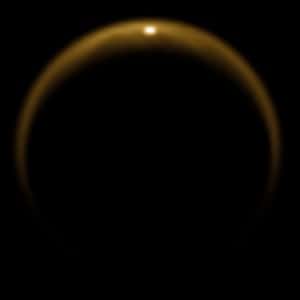

Sailing the Titan Seas: NASA Selects Mission to Saturn’s Moon —
The Johns Hopkins University Applied Physics Laboratory (APL) in Laurel, Md., is managing a project to explore the organic seas of Saturn’s moon Titan, one of three proposals selected by NASA last week as candidates for the agency’s next Discovery Program mission.
The Titan Mare Explorer, or TiME, would perform the first direct inspection of an ocean environment beyond Earth by landing in, and floating on, a large sea of methane (natural gas in a liquid state) on the cloudy, complex moon.
The TiME capsule would launch in 2016 and reach Titan in 2023, parachuting onto the moon’s second-largest northern sea, the Ligea Mare. For 96 days the capsule would study the composition and behavior of the sea and its interaction with Titan’s weather and climate. TiME would also seek evidence of the complex organic chemistry that may be active on Titan today, and that may be similar to processes that led to the development of life on the early Earth.
Titan is the largest moon of Saturn, the only natural satellite known to have a dense atmosphere, and the only object other than Earth for which clear evidence of stable bodies of surface liquid has been found. Titan has a diameter roughly 50% larger than Earth’s moon and is 80% more massive. It is the second-largest moon in the Solar System, after Jupiter’s moon Ganymede, and it is larger by volume than the smallest planet, Mercury, although only half as massive.
Titan was the first known moon of Saturn, discovered in 1655 by the Dutch astronomer Christiaan Huygens (and easily visible in small amateur telescopes as a bright dot close to the ringed planet).
Except for its lakes of liquid natural gas, Titan is primarily composed of water ice and rocky material. Much as with Venus prior to the Space Age, the dense, opaque atmosphere prevented understanding of Titan’s surface until new information accumulated with the arrival of the Cassini–Huygens mission in 2004, including the discovery of liquid hydrocarbon lakes in the satellite’s polar regions. These are the only large, stable bodies of surface liquid known to exist anywhere other than on the Earth.
The climate on Titan—including wind and rain—creates surface features similar to those of Earth, such as sand dunes, rivers and lakes (probably of liquid methane), and shoreline, and, like the climate on Earth, is dominated by seasonal weather patterns. With its liquids (both surface and subsurface) and robust nitrogen atmosphere, Titan is viewed as somewhat like the early Earth, although having a much lower temperature (methane is a liquid only at temperatures below minus 250 degrees Fahrenheit). Titan has thus been cited as a possible host for microbial extraterrestrial life or, at least, as a pre-biotic environment rich in complex organic chemistry. Researchers have suggested that a possible underground liquid ocean there might serve as a biotic environment. It has also been suggested that a form of life may exist on the surface, using liquid methane as a medium instead of water; and, indeed, anomalies in atmospheric composition have been reported which are consistent with the presence of such a life-form, but which could also be due to an exotic non-living chemistry.
You can contact Bob Eklund at [email protected], or visit his website firststarbook.com.





Be the first to comment